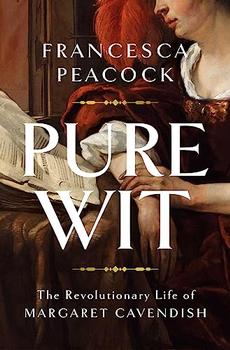Summary | Excerpt | Reviews | Beyond the Book | Readalikes | Genres & Themes | Author Bio

The Revolutionary Life of Margaret Cavendish
by Francesca PeacockIntroduction
The empress and authoress of a whole world
In April 1667, Margaret Cavendish was the talk of London society. At the first performance of The Humorous Lovers – a play everyone believed was by her though it was, in fact, written by her husband, the Duke of Newcastle – she had chosen an extravagantly provocative outfit. Sitting in the audience, she wore a dress so low-cut that "her breasts" were "all laid out to view". As if that boldness were not enough, she had even completed the look with "scarlet trimmed nipples". In a riotously bizarre letter to his father, the young man-about-town Charles North described the situation succinctly: "the Duchess Newcastle is all the pageant now discoursed on". In North's rather fantastical account, she had apparently tried to enter the playhouse in either a "triumphal chariot" pulled by two horses, or an even more glamorous one pulled by "8 white bulls", before then sneaking in "incognito". That same spring, the Restoration diarist Samuel Pepys recorded his attempts to catch a glimpse of the now-famous Duchess of Newcastle. "The whole story of this lady is a romance, and all she do is romantic", he wrote in early April when Cavendish was visiting court. Pepys hoped to be able to see her in Whitehall, when she would be there "to make a visit to the Queen". But, for Pepys, she was herself a kind of royalty: that evening, so many people had heard she was coming to court that she was beset by crowds as if she were the "Queen of Sweden". Two weeks later, he managed to catch sight of her as she rode past in her coach, which was decked out "all in velvet". He describes her appearance in brilliant, obsessive detail – she was wearing a "velvet cap", "black patches" on her face to disguise her pimples, and was "naked- necked" down to her "black just-au-corps", a type of knee-length jacket that was normally reserved for men. "All the town-talk is now-a-days of her extravagancies", he huffed.
Pepys was hardly immune to the general fascination with her. "I hope to see more of her on Mayday", he wrote. He was not the only one who had that idea: on the first of May, Margaret was "followed and crowded upon by coaches all the way she went", to the point that "nobody could come near her". Ten days later, in an image reminiscent of David Bowie being mobbed by adoring fans in the 1970s, or the Beatles being hotly pursued in the 1960s, she was chased by "100 boys and girls running looking upon her". There is something slightly fantastical about these partial sightings: at one moment, all Pepys could see was a "black coach, adorned with silver instead of gold" and everything inside was a dizzying monochrome mix of "black and white". Cavendish was a mysterious, enchanted creature.
But, if much of London thought Margaret was some strange combination of a costumed actress, unreal goddess, and magical princess, not everyone was so convinced. Mary Evelyn – wife of the diarist John Evelyn – visited her at her London home of Newcastle House, Clerkenwell and came away believing that she was insane: "I was surprised to find so much extravagancy and vanity in any person not confined within four walls." She even feared her unnaturalness would be contagious: "I hope, as she is an original, she may never have a copy," she wrote. Mary left in a hurry to avoid "infection". The fact that her husband could not stay away from Margaret could hardly have helped stem her displeasure. In another nugget of gossip, the Lord Chamberlain even had to tell Cavendish to stop dressing her servants at court in "affected velvet caps".
* * *
Who, or what, was this woman? A fairy queen, or insane whore? It wasn't until the end of May 1667 that Pepys had his chance to make Margaret's acquaintance and make up his own mind.
The Royal Society had been founded in 1660, and counted John Evelyn, the chemist Robert Boyle, and the architect Christopher Wren amongst its founding members: it was, unequivocally, the home of male Restoration scientific and scholarly endeavour. Having attacked two of its leading members in her recent publication, Observations upon Experimental Philosophy (1666) just a year earlier, and having satirised the Society as a whole in The Blazing World (1666), Cavendish decided that the time was right to press her case to attend a meeting of the Society. "After much debate, pro and con" and a ballot – many of the eminent men of the Society were against the idea, and feared "the town will be full of ballads" mocking the visit – an invitation was extended to Margaret, the first woman to be welcomed into the Society's then home at Arundel House.
Excerpted from Pure Wit by Francesca Peacock. Copyright © 2024 by Francesca Peacock. Excerpted by permission of Pegasus Books. All rights reserved. No part of this excerpt may be reproduced or reprinted without permission in writing from the publisher.
The whole problem with the world is that fools and fanatics are always so certain of themselves, and wiser people ...
Click Here to find out who said this, as well as discovering other famous literary quotes!
Your guide toexceptional books
BookBrowse seeks out and recommends the best in contemporary fiction and nonfiction—books that not only engage and entertain but also deepen our understanding of ourselves and the world around us.